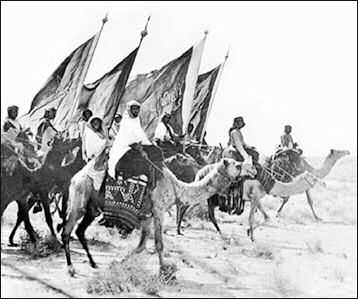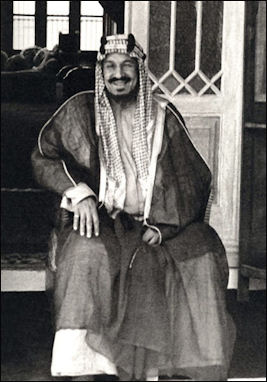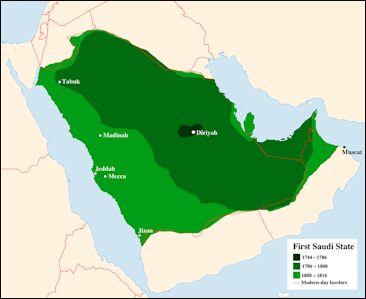Home | Category: Conservative Muslim Groups
WAHHABISM

Flag of Saudi Arabia Wahhabism — a strict, back-to-basics form of Sunni Islam which emphasizes religious purity, strict adherence to Islamic law and a literal interpretations of Islamic texts — was founded in the18th century by Muhammad ibn Abd al-Wahhab, a theologian from the Najd area of Arabia. It is the predominate form of Islam found in Saudi Arabia and has been spread around the world with the help of Saudi wealth.
Wahhabi fundamentalists insist that they do not interpret Islamic texts but simply follow their exact, unambiguous meanings. They reject centuries of legal scholarship as unnecessary “innovation” and regard many Western values as un-Islamic. Christians and non-Wahhabi Muslims are regarded as “unbelievers” who should be avoided. Many of their beliefs aren’t that much different from those of the Taliban.
Steve Coll wrote in The New Yorker, Saudi Arabia’s “dominant school of Islam is often called Wahhabism by non-Saudis, in reference to Muhammad bin Abdul Wahhab, an eighteenth-century desert preacher who allied himself with the al Saud family when it first established political control over the Arabian Peninsula, and whose descendants are still among Saudi Arabia’s most important official clergy. Many Saudis reject the term “Wahhabism” as pejorative; they regard Wahhab’s ideas as Islam itself, properly interpreted, and they argue that no other label is required. Some Saudis acknowledge their country’s dominant theology as a distinct school of Islamic thought, but they will typically refer to this school as Salafism, a term that refers to the beliefs and practices of the earliest followers of Islam. With some exceptions, adherents of the Salafi school steer away from purposeful political organizing; instead, they often emphasize matters of personal faith, such as the strict regulation of Islamic rituals, and of an individual’s private conduct and prayer. Bin Laden’s group at Al Thagher, Batarfi said, was influenced to some extent by Salafi ideas, because there was no escaping the presence of such ideas in Saudi society, but bin Laden’s group adopted “a more activist or a political agenda,” as Batarfi put it, which was drawn largely from the Muslim Brotherhood’s advocacy for political change in Islamic countries. [Source: Steve Coll, The New Yorker, December 12, 2005]
Websites on Muslims Divisions Divisions in Islam archive.org ; Shi’a History and Identity shiism.wcfia.harvard.edu ; What is Shi'a Islam? iis.ac.uk ; Four Sunni Schools of Thought masud.co.uk ; History of Islam: An encyclopedia of Islamic history historyofislam.com ; Oxford Encyclopedia of the Islamic World oxfordislamicstudies.com ; Sacred Footsetps sacredfootsteps.com ; Internet Islamic History Sourcebook fordham.edu/halsall/islam/islamsbook ; Islam IslamOnline islamonline.net ; Institute for Social Policy and Understanding ispu.org; Islam.com islam.com ; BBC article bbc.co.uk/religion/religions/islam ; Islam at Project Gutenberg gutenberg.org
RECOMMENDED BOOKS:
“Wahhabism: The History of a Militant Islamic Movement” by Cole M. Bunze Amazon.com ;
“Ibn Taymiyya (Makers of the Muslim World) by Jon Hoover Amazon.com ;
“Islamism and Islam” by Bassam Tibi Amazon.com ;
“Conservative Islam: A Cultural Anthropology” by Erich Kolig Amazon.com ;
“Salafism and Traditionalism: Scholarly Authority in Modern Islam”
by Emad Hamdeh Amazon.com ;
“The Making of Salafism: Islamic Reform in the Twentieth Century” by Henri Lauzière Amazon.com ;
“Sayyid Qutb and the Origins of Radical Islamism” by John Calvert Amazon.com ;
“Milestones” by Sayed Qutb Amazon.com ;
“The Muslim Brotherhood: Evolution of an Islamist Movement” by Carrie Rosefsky Wickham Amazon.com ;
“Inside the Muslim Brotherhood: Religion, Identity, and Politics” by Khalil al-Anani Amazon.com ;
“Hizb ut-Tahrir: The Untold History of the Liberation Party”
by Reza Pankhurst Amazon.com
Wahhabi Beliefs

Flag of ikhwan One Wahhabi imam told the Washington Post, “For example, if you go home and watch TV every day...that’s not going to help you get close to God. If you go out to the game...or you go to the movies, often if you ;love to go to parties, if you like music — all these things are not going to bring you closer to Allah.” Also forbidden are “love letters, or chatting, in the chat room without the presence of a guardian...or writing e-mails, that you know you have no business writing.”
Wahhabis call for a return to the doctrines and practices of early Islam. Islamic laws are expected to be followed. The veneration of any person, living or dead, is regarded as an attempt to play god, a crime punishable by death. Wahhabis believe that those who flout God’s commandments will burn in hell and that many common place, ordinary things have negative, immoral associations and thus should be avoided.
Xenophobia and intolerance are recurrent themes in modern Wahhabi texts. They urge their followers to avoid smiling at infidels, wishing them well on holidays and calling them friend. A revered imam issued a fatwa that told the faithful living abroad should “harbor enmity and hatred for the infidels and refrain from taking them as friends.” Nonbelievers — including Shiites and Sufis — are regarded as infidels deserving of punishment.
Many Wahhabi beliefs are rooted more in Bedouin social norms than Islamic jurisprudence. Wahhabis oppose almost all forms of modernization. Sometimes their views seem quite heartless. The Saudi Wahhabi Shiek Abdel Aziz Fawzan said the 2004 South Asian tsunami was God’s punishment for the beach resorts allowing “people at Christmas, fornication and sexual perversions of all kinds are rampant.” Some Christians do the same thing. Evangelical Christian Jerry Fallwell made a similar remark about the September 11th attack on New York.
See Taliban
History of Wahhabism
In 1745, Abd al-Wahhab (1703-87), a devout Muslim who regarded the form of Islam practiced in Arabia as corrupt, vowed to return Islam to its original precepts — no idols, no saints and intermediaries between man and God — and launched a campaign of purification and renewal in which Muslims were urged to return to the pure and authentic Islam of Muhammad’s time. Wahhab was greatly influence by the Qur’anic literalism of Ahmad ibn Hanbal (died 855). He felt Islam was being overrun by superstition and Sufi existentialism and viewed the Ottoman Turks, who were Muslims and ruled the Middle East, as corrupt apostates worthy of death. He created a small community of faithful who shared his strict beliefs.
According to the “International Encyclopedia of the Social Sciences”: Wahhabismarose in protest against the laxness and heresies of Sufi versions of the faith in the mid-eighteenth century and which flourished until it was defeated by Ottoman arms in the early nineteenth century. Its influence survived, however, and not only became the basis of the Saudi state but has had profound repercussions among revivalist, purifying movements in India and Africa. Although Sufi orders continued to expand in some areas, such as India, Africa, and fringe Muslim territory, in the nineteenth century, the puritan streak embodied in Wahhabism has in the twentieth century taken strong hold in the more purely Arab countries, where in almost all instances the orthodox version of the faith has been reinforced with the encouragement of and sometimes pressure from the authorities. [Source: Charles F. Gallagher,“International Encyclopedia of the Social Sciences”, 1960s, Encyclopedia.com]
The Wahhabi cause was embraced by the rulers of the Najd area, and by force it was spread across Arabia before being stopped at the end of the 18th century by the Ottoman sultan, who had been accused by the Wahhadis of being a derelict Muslim and an usurper of the Muslim state. A resurgence of Wahhabism occurred in the waning years of the Ottoman Empire and continued after its collapse. Wahhabism was embraced by Ibn Saud, Saudi Arabia’s first king. It was given a boost when Saud captured the holy cities of Mecca and Medina.
In the 20th century Wahabbism became the official ideology of Saudi Arabia and spreading it became a key feature of Saudi Arabia’s foreign policy after the oil boom in the 1970s. The campaign to spread Wahabbism overseas was motivated in part by the threat of presented by radical Shiite Islam after the 1979 Iranian revolution an was intended to be a counter-measure to that.
Al Saud, Najd and Wahhabi Islam

Ikhwan The Al Saud family emerged as the dominant factor in Saudi Arabia’s history. The clan’s origins can be traced to Najd, near Riyadh, beginning in about 1500. As a small town developed, the Al Saud came to be recognized as its leaders, and the clan’s power and influence grew. The rise of the Al Saud coincided with that of the Muslim scholar Muhammad ibn Abd al Wahhab (1703–87), who wrote and preached against leaders and traditions that he deemed contradictory to the idea of a unitary god. Unlike other religious leaders who preached unitarianism, Muhammad ibn Abd al Wahhab demanded that political power be used to implement his theology. In 1744 Muhammad ibn Abd al Wahhab found a political partner in Muhammad ibn Saud, and the two swore a traditional oath to work together in order to establish a state ruled according to Islamic principles. The alliance was based on Muhammad ibn Abd al Wahhab’s claim of religious legitimacy and Muhammad ibn Saud’s readiness to undertake jihad in defense of such principles. By 1765, Muhammad ibn Saud’s forces had established Wahhabism and with it Al Saud political authority over most of Najd. [Source: Library of Congress, September 2006 **]
After Muhammad ibn Saud died in 1765, his son, Abd al Aziz, continued the Wahhabi advance. In 1802 the Al Saud–Wahhabi armies sacked Karbala, including the Shia shrine commemorating Husayn, the martyred grandson of the Prophet Muhammad whom Shia Muslims regard as their spiritual forefather. In 1803 Wahhabi forces moved on to Mecca and Medina. With the assault on the Hijaz, the region of pilgrimage, the Al Saud invited conflict with much of the rest of the Islamic world. Recognizing the symbolic importance of the region, the Ottoman sultan ordered the recapture of the Hijaz, and in 1812 and 1813 Egyptian forces, fighting on behalf of the sultan, regained control of Mecca and Medina. Meanwhile, Muhammad ibn Abd al Wahhab had died in 1792, and Abd al Aziz died shortly before the capture of Mecca. External control of the Hijaz gave the region extensive contact with other parts of the Muslim world. In this regard, the Hijaz differed greatly from the region immediately to the east, Najd.
Najd was relatively isolated. It was more arid and barren than the Hijaz and was surrounded on three sides by deserts and separated from the Hijaz by mountains. All overland routes to the Hijaz passed through Najd, but it was easier to go around Najd. As the caliphs in Baghdad became less powerful, the road between Baghdad and Mecca that led across Najd, declined in importance. After the thirteenth century, pilgrimage traffic was more likely to move up the Red Sea toward Egypt and so bypass Najd. So there were two faces of Arabia. To the west was the Hijaz, which derived a cosmopolitan quality from the foreign traffic that moved continually through it. In the east was Najd, which remained relatively isolated. During the eighteenth century, Wahhabi ideas, vital to the rise of the Al Saud, would originate in Najd. [Source: Helen Chapin Metz, ed. Saudi Arabia: A Country Study, U.S. Library of Congress, 1992 *]
Muhammad ibn Abd al Wahhab (died 1792)
Muhammad ibn Abd al Wahhab (died 1792) was a Muslim scholar whose ideas form the basis of the Wahhabi movement. He grew up in Uyaynah, an oasis in southern Najd, where he studied with his grandfather Hanbali Islamic law, one of the strictest Muslim legal schools. While still a young man, he left Uyaynah to study with other teachers, the usual way to pursue higher education in the Islamic world. He studied in Medina and then went to Iraq and to Iran. [Source: Helen Chapin Metz, ed. Saudi Arabia: A Country Study, U.S. Library of Congress, 1992 *]

Ibn Saud To understand the significance of Muhammad ibn Abd al Wahhab's ideas, they must be considered in the context of Islamic practice. There was a difference between the established rituals clearly defined in religious texts that all Muslims perform and popular Islam. The latter refers to local practice that is not universal. The Shia practice of visiting shrines is an example of a popular practice. The Shia continued to revere the Imams even after their death and so visited their graves to ask favors of the Imams buried there. Over time, Shia scholars rationalized the practice and it became established.*
Some of the Arabian tribes came to attribute the same sort of power that the Shia recognized in the tomb of an Imam to natural objects such as trees and rocks. Such beliefs were particularly disturbing to Muhammad ibn Abd al Wahhab. In the late 1730s he returned to the Najdi town of Huraymila and began to write and preach against both Shia and local popular practices. He focused on the Muslim principle that there is only one God, and that God does not share his power with anyone — not Imams, and certainly not trees or rocks. From this unitarian principle, his students began to refer to themselves as muwahhidun (unitarians). Their detractors referred to them as "Wahhabis" — or "followers of Muhammad ibn Abd al Wahhab," which had a pejorative connotation.*
The idea of a unitary god was not new. Muhammad ibn Abd al Wahhab, however, attached political importance to it. He directed his attack against the Shia. He also sought out local leaders, trying to convince them that this was an Islamic issue. He expanded his message to include strict adherence to the principles of Islamic law. He referred to himself as a "reformer" and looked for a political figure who might give his ideas a wider audience.*
Lacking political support in Huraymila, Muhammad ibn Abd al Wahhab returned to Uyaynah where he won over some local leaders. Uyaynah, however, was close to Al Hufuf, one of the Twelver Shia centers in eastern Arabia, and its leaders were understandably alarmed at the anti-Shia tone of the Wahhabi message. Partly as a result of their influence, Muhammad ibn Abd al Wahhab was obliged to leave Uyaynah, and headed for Ad Diriyah. He had earlier made contact with Muhammad ibn Saud, the leader in Ad Diriyah at the time, and two of Muhammad's brothers had accompanied him when he destroyed tomb shrines around Uyaynah.*
Saud Family and Wahhabi Islam
The Al Saud originated in Ad Diriyah, in the center of Najd, close to the modern capital of Riyadh. Around 1500 ancestors of Saud ibn Muhammad took over some date groves, one of the few forms of agriculture the region could support, and settled there. Over time the area developed into a small town, and the clan that would become the Al Saud came to be recognized as its leaders. [Source: Helen Chapin Metz, ed. Saudi Arabia: A Country Study, U.S. Library of Congress, 1992 *]
The rise of Al Saud is closely linked with Muhammad ibn Abd al Wahhab. When Muhammad ibn Abd al Wahhab arrived in Ad Diriyah, the Al Saud was ready to support him. In 1744 Muhammad ibn Saud and Muhammad ibn Abd al Wahhab swore a traditional Muslim oath in which they promised to work together to establish a state run according to Islamic principles. Until that time the Al Saud had been accepted as conventional tribal leaders whose rule was based on longstanding but vaguely defined authority.*
Muhammad ibn Abd al Wahhab offered the Al Saud a clearly defined religious mission to which to contribute their leadership and upon which they might base their political authority. This sense of religious purpose remained evident in the political ideology of Saudi Arabia in the 1990s.*
Saud Family and Wahhabis Take Control of Mecca
Muhammad ibn Saud began by leading armies into Najdi towns and villages to eradicate various popular and Shia practices. The movement helped to rally the towns and tribes of Najd to the Al Saud-Wahhabi standard. By 1765 Muhammad ibn Saud's forces had established Wahhabism — and with it the Al Saud political authority — over most of Najd. [Source: Helen Chapin Metz, ed. Saudi Arabia: A Country Study, U.S. Library of Congress, 1992 *]

First Saudi State After Muhammad ibn Saud died in 1765, his son, Abd al Aziz, continued the Wahhabi advance. In 1801 the Al Saud-Wahhabi armies attacked and sacked Karbala, the Shia shrine in eastern Iraq that commemorates the death of Husayn. In 1803 they moved to take control of Sunni towns in the Hijaz. Although the Wahhabis spared Mecca and Medina the destruction they visited upon Karbala, they destroyed monuments and grave markers that were being used for prayer to Muslim saints and for votive rituals, which the Wahhabis consider acts of polytheism. In destroying the objects that were the focus of these rituals, the Wahhabis sought to imitate Muhammad's destruction of pagan idols when he reentered Mecca in 628.*
If the Al Saud had remained in Najd, the world would have paid them scant attention. But capturing the Hijaz brought the Al Saud empire into conflict with the rest of the Islamic world. The popular and Shia practices to which the Wahhabis objected were important to other Muslims, the majority of whom were alarmed that shrines were destroyed and access to the holy cities restricted.*
Moreover, rule over the Hijaz was an important symbol. The Ottoman Turks, the most important political force in the Islamic world at the time, refused to concede rule over the Hijaz to local leaders. At the beginning of the nineteenth century, the Ottomans were not in a position to recover the Hijaz, because the empire had been in decline for more than two centuries, and its forces were weak and overextended. Accordingly, the Ottomans delegated the recapture of the Hijaz to their most ambitious client, Muhammad Ali, the semi-independent commander of their garrison in Egypt. Muhammad Ali, in turn, handed the job to his son Tursun, who led a force to the Hijaz in 1816; Muhammad Ali later joined his son to command the force in person. Meanwhile, Muhammad ibn Abd al Wahhab had died in 1792, and Abd al Aziz died shortly before the capture of Mecca. The movement had continued, however, to recognize the leadership of the Al Saud and so followed Abd al Aziz's son, Saud, until 1814; after Saud died in 1814, his son, Abd Allah, ruled. Accordingly, it was Abd Allah ibn Saud ibn Abd al Aziz who faced the invading Egyptian army.
Tursun's forces took Mecca and Medina almost immediately. Abd Allah chose this time to retreat to the family's strongholds in Najd. Muhammad Ali decided to pursue him there, sending out another army under the command of his other son, Ibrahim. The Wahhabis made their stand at the traditional Al Saud capital of Ad Diriyah, where they managed to hold out for two years against superior Egyptian forces and weaponry. In the end, however, the Wahhabis proved no match for a modern army, and Ad Diriyah — and Abd Allah with it — fell in 1818.*
Wahhabi in Saudi Arabia
Wahhabi values and beliefs are indoctrinated in Saudi schools. A typical passage from a 6th garde textbook reads: “Arabs and Muslims will succeed, God willing, in beating the Jews and their allies.” A 10th grade textbook reads: “It is compulsory for the Muslims to be loyal to each other and to consider the infidels their enemies.”
The imam at the Sacred Mosque in Mecca has called Jews “pigs and monkeys,” described the West as a “poisonous culture” with “rotten ideas” and condemned Hinduism. Islamic scholars that expressed sympathy for the September 11th victims and suggested there be some common ground between Muslims and the West have been harangued and ridiculed.
The Saudi royal family are not big supporters of Wahhabism but their bond with the sect goes back to the 18th century and the feel they are not in a position to challenger it. Liberals are scared of them. One liberal Saudi told the New York Times, “If you are against them, you are against Islam. If you criticize them, you criticize Islam.
Spread of Wahhabism and Terrorism
The Saudi government is engaged in spreading Wahabbism with missionary zeal throughout South Asia, the Middle East and Central Asia.
Some 3,000 madrasahs have been set up with Zakat money — much of its supplied by Saudi ruling family in Pakistan and Central Asia. Money from the same sources has been used to build mosques in Indonesia and Islamic centers in Europe and the United States.
At these madrasahs, there is a very strong anti-West, ant-American slant. In many Osama bin Laden is applauded. The schools that produced the Taliban were founded with Saudi-Wahhabi money. See Pakistan
Osama bin Laden, the Egyptians who carried out the Luxor attack, Taliban-style guerillas in Kashmir , radical Algerians are influenced by Wahhabism. The Taliban originated in Saudi-financed madrasahs in Pakistan.
Explaining that links between Wahhabism and terrorism are unfounded one scholar told the New York Times, “Of course I hate you because you are Christian but that doesn’t mean I want to kill you.”
Text Sources: Internet Islamic History Sourcebook: sourcebooks.fordham.edu ; Arab News, Jeddah; “Islam, a Short History” by Karen Armstrong; “A History of the Arab Peoples” by Albert Hourani (Faber and Faber, 1991); “World Religions” edited by Geoffrey Parrinder (Facts on File Publications, New York); “Encyclopedia of the World’s Religions” edited by R.C. Zaehner (Barnes & Noble Books, 1959); Metropolitan Museum of Art, Encyclopedia.com, National Geographic, BBC, New York Times, Washington Post, Los Angeles Times, Smithsonian magazine, The Guardian, Al Jazeera, The New Yorker, Time, Newsweek, Reuters, Associated Press, AFP, Library of Congress and various books and other publications.
Last updated April 2024
